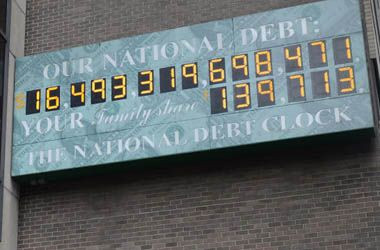Why A US Default Wouldn't Be The First Ever [VIDEO]

House Republicans on Thursday proposed a plan for a temporary increase in the nation's borrowing limit in order to avoid a U.S. default; however, a New York Times report said President Obama rejected the proposal, sending stock futures lower.
Congress is continuing negotiations in order to agree to a short-term spending plan to fund the government and raise the debt ceiling to avoid a possible first-ever United States default next week; but, would this really be the first time the U.S. has ever defaulted?
“For the United States to say we don’t default on debt, that’s not, by the letter of law maybe that’s true, but that’s not necessarily true,” said David Williams, director at Strategic Gold Corporation. “We’ve defaulted often times in the past, 1971 being the latest example when we went off the gold standard. The Europeans were coming to the United States and turning their dollars in for gold, which they were allowed to do, and we said ‘No thank you. We’re not going to allow that to happen anymore.’ The gold price went from upwards of $35 an ounce to $850 an ounce over a period of about 10 years.”
In fact, the United States defaulted in 1979, inadvertently, when lawmakers waited until the 11th hour before raising the debt ceiling. The U.S. defaulted back then due to errors in the Treasury’s back office.
“The Treasury blamed this delay on an unprecedented volume of participation by small investors, on failure of Congress to act in a timely fashion on the debt ceiling legislation in April, and on an unanticipated failure of word processing equipment used to prepare check schedules,” said Terry Zivney and Richard Marcus in The Financial Review in 1989.
Wall Street had soared Thursday, as all major averages gained more than 2 percent at the close, after investors believed political leaders in Washington were edging closer to a deal to resolve the government shutdown.
The Dow Jones industrial average rose 323.09 points or 2.18 percent, to close at 15,126.07. The S&P 500 gained 36.16 points or 2.18 percent, to end at 1,692.56. The Nasdaq Composite added 82.971 points or 2.26 percent, to finish at 3,760.747.
Although gold was thought to jump higher over the last week amid uncertainty over the U.S. shutdown, gold futures fell to the lowest settlement price since the dispute began on Oct. 1. Gold futures for December delivery fell $10.30, or 0.8 percent, to close at $1,296.90 an ounce Thursday on the New York Mercantile Exchange.
“The gold trade since this crisis has occurred has actually been different than what we thought. We thought we might get a little pop in gold just as a safe haven, and it hasn’t occurred,” Williams said. “We’re down at around $1,300 which is an important level, but we’ll have to see what happens in the next few days.”
Also on Thursday, the European Central Bank (ECB) and the People's Bank of China (PBOC) agreed to a currency swap that will last for three years and provide a maximum of 350 billion yuan to the ECB and 45 billion euros to the PBOC.
“Right now the Chinese today made a deal with the ECB that their swapping reserves, RMB for Euros,” said Williams. “The dollar as a reserve currency, the world is going to fade if we keep fooling around like this with our currency. If that’s the case, sooner or later that’s going to come back to catch-up with us. It’s going to hurt us.”
© Copyright IBTimes 2025. All rights reserved.






















